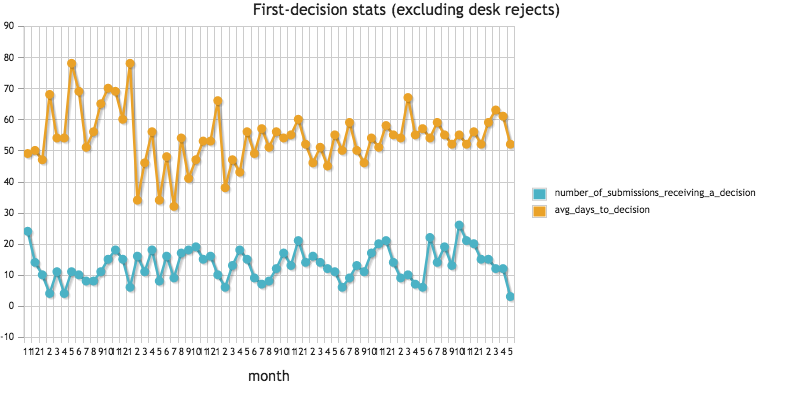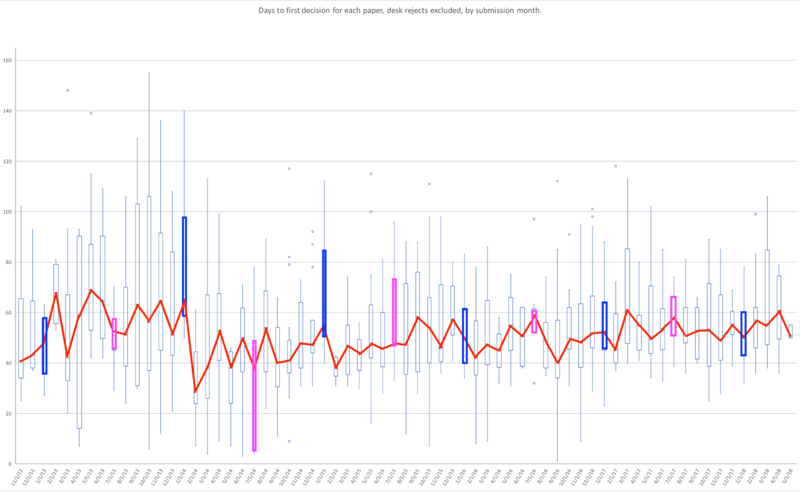2018Q3 Reports: TACL Journal Editor
Transition to MIT Press
We have been working to transition the publication process to MIT Press, and we have a target goal that MIT Press will start publishing TACL papers in July 2018 and back-publish all TACL 2018 papers by the end of July and all TACL papers by September.
This is Big News for TACL! Here are some implications:
- The cost of TACL to the ACL has risen a lot. The TACL EiCs believe the cost is worth it.
- Indexing: it is recognized that the application/approval process for Scopus and Web of Science can take several years. But MIT Press will, simultaneously, send metadata to the following "discovery services": ACM, CNKI, cnpLINKer, EBSCO EDS, Ex Libris, IBZ, IET, Informatics, Meta, Modern Library Association of America, Naver, OCLC Discovery, Summon, TDNET, Yewno.
- Processing of papers:
- MIT Press would like the processing of camera-readies to work through Overleaf, which would mean authors would need to submit LaTeX source. We have been discussing whether Word documents can also be handled by MIT Press. (In the past, TACL simply worked with pdfs supplied by the authors)
- The copy-editing that MIT Press would engage in would begin after the TACL Action Editor signs off on the author camera-ready to make sure nothing too dramatic happened between acceptance and final version. We imagine this will change the TACL workflow so that authors submit camera-ready source to Overleaf and AEs do a final review there.
- The prospect of working with Overleaf offers us the opportunity (or forces us to into the process of) revamping the TACL style files, including deciding on whether to switch to A4 and other such multifarious details.
Editor-in-Chief transition and other personnel information
Co-editor-in-chief Kristina Toutanova's term ended June 30, 2018, and Brian Roark's term as co-editor-in-chief officially begins July 1, 2018. All hail Kristina for her incredible service!
Looking ahead:
- The ACL resolved in 2015 that TACL will have three co-editors-in-chief until 2020 to complete the work needed to bring TACL out of "start-up mode".
- Co-editor-in-chief Lillian Lee's second term ends December 31, 2019. She does not currently anticipate putting her name in the hat for a third term. (The ACL allows TACL co-EiCs three 3-year terms).
- Co-editor-in-chief Mark Johnson's second term ends June 30, 2020.
TACL has about 50 Action Editors and a bit over 200 people in the standing elite reviewer pool. Our AEs and standing reviewers are listed at: https://transacl.org/ojs/index.php/tacl/about/editorialTeam .
Statistics
Time to first decision
First, we show, in blue, the number of submissions that received their first decision (see caveats at the end of this paragraph), and, in yellow, the average time in days to first decision; both of these types of data are grouped by round (=nearest first-of-the-month). The decision time for papers submitted for a given month is counted as starting from the first of that month. Caveats: this plot excludes desk rejects, first versions of papers that were not considered due to minor technical formatting problems, and papers handled using START (the early days of TACL). Also, papers submitted in June have not yet received decisions.
Observations:
- The average time to decision has, with exceptions, been bouncing between 50-60 days. The ideal timeline would be 45 days (1 week for EiC to assign an AE; 1 week for AEs to assign reviewers; 3 weeks for reviewers to review; 7-10 days for AEs to organize discussion and decide. So we are running about a week or week and a half, on average, later than we would ideally be.
- Time to first decision seems to spike around February or March. Anecdotal evidence suggests that one cause is Action Editor and reviewer commitments to conference (or burnout from said commitments), and another is a number of people changing professional positions. Admittedly, another contributing factor could be that the spring semesters constitute very heavy teaching loads for one of the co-EiCs.
- Perhaps not surprisingly, the number of submissions appears to drop during conference-submission seasons.
- On the positive side, ACL-wide automatic checking for duplicate submissions should help reduce the amount of time EiCs spend pre-processing submissions before assignment to AEs, which should help speed up the AE-assignment part of the pipeline.
Additionally, it should be pointed out that for the past 12 months, the average time that our reviewers took to complete a review (if they completed it) was 24.4 days, which is gratifyingly close to the requested timeframe of 21 days.
Next, we show, in light blue, the variance (via box-and-whisker plots) in the number of days to first decision, grouped by submission round. The red line shows the median. The higlighted blue and magenta bars mark January and July submission rounds, with the intent of highlighting any seasonal trends.
Observations:
- The median is, of course, less spiky than the mean shown in the first plot.
Distribution of first decisions
We had 167 paper submitted from June 2017 through June 2018, inclusive, that received a first decision . Of those, 12 were desk-rejected. Of the 155 left, the decision breakdown was:
2% (a) = accepted as is 17% (b) = conditional accept: acceptance guaranteed if conditions met 55% (c) = rejected, encourage resubmission but no guarantee of acceptance 26% (d) = rejected with 1-year moratorium on TACL submission.
Of the additional 35 resubmissions of (c)s that were submitted during the same period and received a decision, 48% received a conditional accept or an accept. 45% received a (d), as TACL policy is to not give two (c)s in a row. The remaining two were special cases that had to be handled differently.
Publishing statistics
The 2018 volume has had 28 papers published so far, with 8 camera-readies in hand to be processed, and 5 papers that have received (a) but where camera-readies have not yet been submitted.

